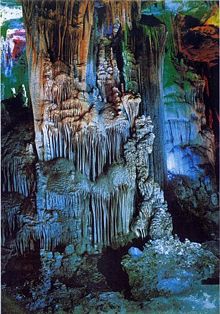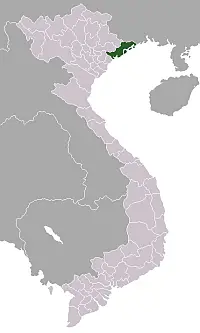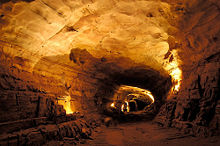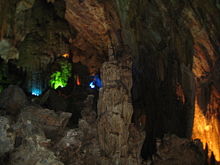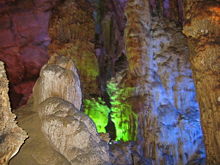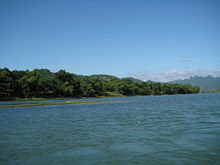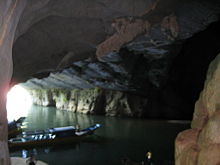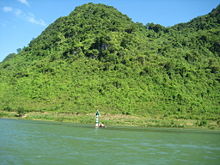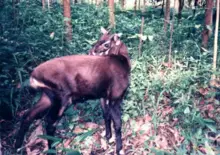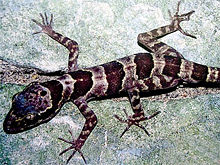Phong Nha-Ke Bang
| Phong Nha-Ke Bang National Park* | |
|---|---|
| UNESCO World Heritage Site | |
| State Party | |
| Type | Natural |
| Criteria | viii |
| Reference | 951 |
| Region** | Asia-Pacific |
| Inscription history | |
| Inscription | 2003 (27th Session) |
| * Name as inscribed on World Heritage List. ** Region as classified by UNESCO. | |
Phong Nha - Ke Bang (Vietnamese: Vườn quốc gia Phong Nha-Kẻ Bàng) designates a national park and UNESCO World Heritage Site in the Bố Trạch and Minh Hóa districts of central Quang Binh Province, in north-central Vietnam, about 500 kilometers south of the nation's capital, Hanoi. The park borders the Hin Namno Nature Reserve in the province of Khammouan, Laos by the west, 42 kilometers east of South China Sea from its point. Phong Nha-Ke Bang National Park sits in a limestone zone of 200,000 hectare in Vietnamese territory and borders another limestone zone of 200,000 hectares of Hin Namno in Laotian territory. The core zone of the national park covers 85,754 hectares and a buffer zone of 195,400 ha.[1] The Vietnamese government created the park to protect one of the world's two largest karst regions with 300 caves and grottoes and also protects the ecosystem of limestone forest of the Annamite Range region in north central coast of Vietnam. [2]
Phong Nha-Ke Bang area has been noted for its cave and grotto systems, composed of 300 caves and grottos, with a total length of about 70 kilometers, of which only twenty have been surveyed by Vietnamese and British scientists; seventeen of them in located in the Phong Nha area and three in the Ke Bang area. Phong Nha holds several world cave records, as it has the longest underground river, as well as the largest caverns and passageways.[1]
The park derives it name from Phong Nha cave, the most beautiful of all, containing many fascinating rock formations, and Ke Bang forest.[3] The plateau on which the park represents one of the finest and most distinctive examples of a complex karst land form in Southeast Asia.[4]
Exploration
Champa inscriptions carved on steles and altars in the cave demonstrate that people had inhabited the cave long before Vietnam annexed the area in the nam tien southward expansion. In 1550, Dương Văn An became the first Vietnamese man to write about Phong Nha cave. Phong Nha cave has been depicted in 9 urns in the Citadel of the Nguyen Dynasty in Huế.[1] In 1824, king Minh Mang conferred the title "Diệu ứng chi thần" (Han Tu: 妙應之神) on Phong Nha cave. Nguyen kings bestowed the title "Thần Hiển Linh" (Han Tu: 神顯靈).
In the late 19th century, Léopold Michel Cadière, a French Catholic priest, conducted an expedition to explore Phong Nha cave, where he discovered Champa scripts. He proclaimed Phong Nha cave "the number one cave of Indochina"[5]. In July 1924, an English expeditionist, Barton, declared Phong Nha cave second to none of famous caves of Padirac (France), Cuevas del Drach (Spain) in respect to beauty and miracles.[6]
In 1935, a local inhabitant accidentally discovered a beautiful cave one kilometer from Phong Nha cave mouth, at an elevation of 200 meters. The came received the name Tien Son cave (lit.: Fairy-tale cave), or Dry cave because of the lack of an underground river. In 1937, the Bureau of Tourism of French Resident Superior (in Huế) issued a brochure to promote tourism in Quang Binh, introducing Phong Nha Cave in the introduction. Before 1990, Vietnamese and foreign groups conducted several explorations. From 1990 the number of discovery and research expeditions increased dramatically, leading to a drafting of documents recommending the site as a UNESCO for World Natural Heritage designation.
Geography
The Vietnamese government officially declared The Phong Nha Nature Reserve on 9 August 1986, designating an area of 5,000 ha, extending that to 41,132 ha by 1991. On December 12, 2001, the Vietnamese Prime Minister announced upgrading the nature reserve to a national park to protect the biodiversity of the park, especially rare species of fauna and flora native to the region. The park covers a total area of 857.54 square kilometers divided into three zones, a "strictly protected zone" (648.94 km²), an "ecological recovery zone" (174.49 km²), and an "administrative service zone" (34.11 km²).
Climate
The climate in the national park, tropical, hot, and humid, has an annual mean temperature of 23 to 25 °C, with a maximum of 41 °C in the summer and a minimum of 6 °C in the winter. The hottest months fall between June to August, with an average temperature of 28 °C, and the coldest months from December to February with an average temperature of 18 °C. Annual rainfall measures 2,000 mm to 2,500 mm, and 88 percent of the rainfall between July to December. Mean annual relative humidity measures 84 percent.
History of formation
The Phong Nha–Ke Bang karst has evolved since the Paleozoic (some 400 million years ago) and so is the oldest major karst area in Asia. It has been subject to massive tectonic changes, and comprises a series of rock types that are interbedded in complex ways. Probably as many as seven different major levels of karst development have occurred as a result of tectonic uplift and changing sea levels, thus the karst landscape of PNKB is extremely complex with high geodiversity and many geomorphic features of considerable significance. Like much of Vietnam, it has been subject to extensive tectonic change, and so the limestones of Phong Nha are inter-bedded with a number of other rocks. There is also strong evidence that sulphurous solution and hydrothermal action have played an important role in shaping the broad-scale landscape and the caves, though this has not yet been properly assessed.
Phong Nha-Ke Bang area today is a result of 5 stages of Earth's crust development and movement in this area:
- Late Ordovician - Early Silurian Stage (about 450 Ma)
- Middle-late Devonian Stage (about 340 Ma)
- Carboniferous-Permian (about 300 Ma)
- Mesozoic Orogenic stage
- Cenozoic stage.
Geological significance
Phong Nha-Ke Bang National Park is one of the world's two largest limestone regions. In comparison with 41 other world heritage sites which have karsts, Phong Nha has dissimilar geomorphic, geologic and biotic conditions. The karsts of Phong Nha can be traced back to Palaeozoic era, 400 million years ago. This makes Phong Nha the oldest major karst in Asia. If the Hin Namno, bordering Phong Nha on the west (in Laotian territory) was to be combined with the national park in a continuous reserve, the combined reserve would be the largest surviving karst forest in South-east Asia (317,754 ha).
In general, there are two groups of landforms in the Phong Nha - Kẻ Bàng area, namely non-karstic and karstic landforms. Non-karstic landforms includes three types: The middle and low dome-block mountains developed in intrusive magmatic massifs; The middle denudation-structural mountain belts developed in terrigenous rocks of Cretaceous age; and The low block-denudational mountain belts developed in other terrigenous rocks.
Karstic landforms in this area are of typical tropical karst which are divided into two groups of forms: The karstic forms on the surface including cone and tower karst, karrens, valleys and dolines, border polje, etc; The underground karst consisting of caves.
In comparison with three other national parks listed in UNESCO's World Heritage Sites in Southeast Asia, namely Gunung Mulu National Park in Malaysia, Puerto Princesa Subterranean River National Park in Palawan of the Philippines and Lorentz National Park in West Irian of Indonesia and some other karst regions in Thailand, China, Papua New Guinea, karst in Phong Nha-Ke Bang is older, has more complicated geological structure; diverse and complex underground rivers. [2]
Mounts and summits
Phong Nha - Ke Bang also contains two dozens of mountain peaks with over 1,000 metres in height. Noteworthy peaks are the Peak Co Rilata with ta height of 1,128 m and the Peak Co Preu with a height of 1,213 m.
Mounts in karstic area of the park rise at typical height of above 800 m constitute a continuous range along Laotian-Vietnamese borderline, of which notable summits above 1000 m are: Phu Tạo (1174 m), Co Unet (1150 m), Phu Canh (1095 m), Phu Mun (1078 m), Phu Tu En (1078 m), Phu On Chinh (1068 m), Phu Dung (1064 m), Phu Tu Ôc (1053 m), Phu Long (1015 m), Phu Ôc (1015 m), Phu Dong (1002 m). Inserting into these summits are 800-1000 m high summits of Phu Sinh (965 m), Phu Co Tri (949 m), Phu On Boi (933 m), Phu Tu (956 m), Phu Toan (905 m), Phu Phong (902 m), núi Ma Ma (835 m).
Non-karstic topograhical area accounts for a low percentage, distributing mainly in outer circle of limestone in the north, northeast and southeast of this national park. The height of these summits varies from 500-1000 m with the deep divisions and high sloping level from 25-30o. There are some narrow valleys along streams such as Am creek, Cha Lo creek, Chua Ngút creek and a valley along Rao Thuong river in the southernmost edge. In the north-south direction, there exists notable summits: Phu Toc Vu (1000 m), Mã Tác (1068 m), Cổ Khu (886 m), U Bò (1009 m), Co Rilata (1128 m); The highest summit in the non-karstic area and also the highest summt of this national park is Co Preu (1213 m), a summit in the southernmost edge of the park.
Rivers and streams
Besides the grotto and cave systems, Phong Nha has the longest underground river. The Son and Chay are the main rivers in this national park. Most of caves here have been shaped by Son and Chay Rivers. The Son River flows into the mouth of the Phong Nha cave and keeps on underground, where it is called as the Nam Aki River. It emerges 20 km to the south near Pu-Pha-Dam Mountain.
There are over ten spectacular streams, springs and waterfalls in Phong Nha-Ke Bang area, namely: Gió waterfall, Madame Loan waterfall, Mọc stream erupting from a limestone mount range, and Trạ Ang stream.[7]
Cave and grottoes
Phong Nha-Ke Bang covers 300 different grottoes and caves. Phong Nha cave is assessed by BCRA as the top cave in the world due to its 4 top records: the longest underground river, the highest and longest cave, broadest and most beautiful fine sand beaches inside the caves, the most spectacular stalagmites and stalactites.[8]
According to the assessment of UNESCO, The karst formation of Phong Nha-Ke Bang National Park has evolved since the Palaeozoic (some 400 million years ago) and so is the oldest major karst area in Asia[4] and Phong Nha displays an impressive amount of evidence of earth’s history. It is a site of very great importance for increasing our understanding of the geologic, geomorphic and geo-chronological history of the region.[4]
Emythology
The name Phong Nha-Ke Bang includes Phong Nha cave and Ke Bang limestone forest. Phong Nha is widely explained as originating from Hán tự: 风牙, which means wind-tooth (wind flowing from the cave and stalactites and stalagmites inside the cave looking like teeth)[9][10], but other theorires suggest that Phong Nha is the name of a nearby village and therefore, its name has nothing to do with wind and teeth as widely explained[11][5]
According to Lê Quý Đôn, Phong Nha was the former name of a nearby village.[12] Other theory suggests that, Phong Nha derived its name from the imagination that mounts in this region standing in line looks similar to the scene of mandarins in front of the king in royal courts, therefore, it was named Phong Nha (Han Tu: phong (峰) means "summit" and nha (衙) means "mandarin").[13]
Other names of Phong Nha cave includes: Thầy Tiên cave, Thầy Mount, and Troóc cave.[14]
The Phong Nha cave
This cave from which the name to the whole system and the park is derived is famous for its rock formations which have been given names such as the "Lion," the "Fairy Caves," the "Royal Court," and the "Buddha." This cave is 7729 m long, contains 14 grottos, with a 13,969 m-long underground river. The scientists have surveyed 44.5 km of grottos in this cave so far, but tourists can only penetrate to a distance of 1500 m.[1] Phong Nha Caves, like most of the caves in this area, has been continuously shaped by the Chay River. As one gets farther into the cave, the more illusory the stalactites and stalagmites look as they glitter when bright light is shone on them. The Son River flows into the mouth of the cave and keeps flowing underground, where it is referred to as the Nam Aki River, then this river emerges at a site 20 km to the south near Pu Pha Dam Mountain. The main Phong Nha cave includes 14 chambers, connected by an underwater river that runs for 1.5km. Secondary corridors branch off in all directions. The Outer Cave and some of the Inner Caves have roofs that tower between 25 and 40 meters above the water level. From the 14th chamber there may be other corridors leading to similarly large chambers, but this area proves more dangerous for explorers because of the ongoing erosion of the limestone of the cavern. The Shallow cave is located 800 meters from the cave mouth, where there is a spectacular landscape of sand and rock. Stalactites and stalagmites jut out like strange trees, exciting visitor’s imaginations.[15] Notable caves and grottos: Phong Nha Cave system:
- Dark Grotto (Hang Tối): located upstream of Son River running to the branch of Chay River on the left. This cave is 5,258 m long and with a height of 83 m. The entry is high and wide with heavy forest around the cave mouth.
- E Grotto (Hang E): a 736 m-long grotto accessible by Ho Chi Minh Trail.
- Cha An Grotto (Hang Chà An): a 667 m-long grotto, with the width of 15 m.
- Thung Grotto (Hang Thung): This grotto has an underground river of 3351 m, with the height in some part exeed 133 . This river receives water resources from Rao Thuong.
- En Grotto (Hang Én): a 1645 m long, 78.6 m high grotto. The grotto is wide, there is fine sand field inside. This grotto is the habitat of thousands of sparrows.
- Khe Tien Grotto (Hang Khe Tiên): located south of Phong Nha, this grotto is 520 m long.
- Khe Ry Grotto (Hang Khe Ry): located south of Phong Nha. The grotto is where the stream Khe Ry (a 13.817 km or 8.585 mi long stream at the elevation of 120 m, originating from a mount 1300 m high) runs out.
- Khe Thi Grotto (Hang Khe Thi): The Khe Thi stream originating from the mount and runs underground at this grotto.
Vom Cave systems
- Vom Grotto (Hang Vòm): a 15.05 km long, 145 m high grotto with several underground rivers, pools. This grotto features several spectacular stalagmite and stalactites.
- Dai Cao Grotto (Hang Đai Cao): this grotto is a connection of Vom Grotto. This grotto is 1645 m long, 28 m high..
- Duot Grotto (Hang Duột): This is a connection of Dai Cao Grotto with the length of 3.927 km and height of 45 m. There are some fine sand fields inside.
- Ca Grotto (Hang Cá): a 1,500 m long, 62 m high grotto.
- Ho Grotto (Hang Hổ): A connection of Ca Grotto with the length of 1,616 m and the height of 46 m
- Over Grotto (Hang Over): a 3,244 m long, 103 m high grotto, with the width from 30–50 m.
- Pygmy Grotto (Hang Pygmy): This 845 m long grotto has several streams falling from mounts.
- Ruc Caroong Grotto (Hang Rục Caroòng): This the habitat of Arem ethnic group. They live in the caves, grottos and on hunting, harvesting natural products.[16]
Tien Son Cave
Tien Son cave is another beautiful cave in Phong Nha-Ke Bang area. Tien Son cave was discovered by a local inhabitant by accident in 1935.[17] It is located in Son Trach Commune, Bo Trach District. The entry mouth of Tien Son is 1 km from Phong Nha cave, at an altutude of 200 m. This cave is 980 m in length. A 10 m deep hole is situated 400 m from the entry mouth, then a 500 m long underground cave, dangerous for tourists and therefore is open to professional expeditionists only. Like Phong Nha cave, this cave features spectacular stalactites and stalagmites shaped like several fairy-tales. Stalactite and stalagmite columns and walls here create strange sounds like that of gong and drum if they are knocked with the hand. According to British cave scientists, Tien Son cave was created tens of million years ago when a water current holed this limestone mount in Ke Bang. Following a series of landforms and movement of rocks, this mass was levered or lowered, blocking the current and creating what is now Tien Son cave while the underground river redirected its current to Phong Nha cave. Although Phong Nha and Tien Son caves are located next to each other, there are no linking grottos between them.[18]
Thien Duong Cave
Thien Duong (Paradise) Cave is a newly found cave in this area. It is regarded by British cave scientists as the largest and longest cave in Phong Nha-Ke Bang, with the most beautiful and spectacular stalactites and stalagmites in the park. Nevertheless, tourists are only able to visit some hundred meters and a comprehensive survey has not been conducted yet due to the danger it may create in the farther side and therefore knowledge of this cave is limited and it remains a mystery to the scientists.[19]
Biodiversity in the park
Florae
The park is part of the Annamites eco-region. By far the largest vegetation type is tropical dense moist evergreen forest on limestone under 800 m above sea level. 96.2% of this national park is covered with forest, 92.2% of which is intact primary forest. 74.7% (110,476 ha) of the park is covered with evergreen tropical wet forest on limestone rocks at the elevation of under 800 m; 8.5% (12,600 ha) is evergreen tropical wet forest on limestone rocks at the elevation of above 800 m; 8.3% (12,220 ha) evergreen tropical wet forest on soil mounts at the elevation of under 800 m; evergreen tropical wet forest on limestone rocks at the elevation of under 800 m; 0.7% (1,070 ha) evergreen tropical wet forest on limestone rocks at the elevation of above 800; 1.1% impacted evergreen tropical wet forest on limestone rocks; 2.8% (4,212 ha) impacted evergreen tropical wet forest on soil mounts; 1.3% (1,925) grass, bush on limestone rocks; 2% (2,950 ha) grass, bush on soil mounts; permanent wetland forest: 180 ha; rattan and bamboo forest: 150 ha; and agricultural plants: 521 ha or 0.3%.[20] According to the results of initial surveys, the primary tropical forest in Phong Nha - Ke Bang 140 families, 427 genera, and 751 species of vascular plants, of which 36 species are endangered and listed in the Vietnam's Red Data Book.
The most commont tree species in this park are Hopea sp., Sumbaviopsis albicans, Garcinia fragraeoides, Burretionendron hsienmu, Chukrasia tabularis, Photinia aroboreum and Dysospyros saletti. Seedlings can only grow in holes and cracks in the limestone where soil has accumulated, so in general regeneration after disturbance is slow.
The forest type in this national park is dominated by evergreen tree species with scattered deciduous trees such as Dipterocarpus kerri, Anogeissus acuminate, Pometia pinnata and Lagerstroemia calyculata.
In this park, the dominant plant families are the Lauraceae, Fagacaeae, Theaceae and Rosaceae, with some scattered gymnosperms such as Podocarpus imbricatus, Podocarpus neriifolius, and Nageia fleuryi.[20]
In this national park, there exists a 5000-ha forest of Calocedrus macrolepis on limestone (Calocedrus rupestris) mounts with about 2,500 trees, 600 per hectare. This is the largest forest with this tree in Vietnam. Most of the trees here are 500-600 years old. These trees are listed in group 2A (rare, precious and limited exploitation) of the official letter 3399/VPCP-NN dated 21 June 2002, an amendment to the Decree 48 by the Government of Vietnam.[21]
Natural University, Hanoi National University, in combination with the Research Center of Phong Nha-Ke Bang National Park, has discovered 1,320 additional species in this park, of which some groups are assessed as specially rare and precious.[21]
Biologists have discovered three rare orchid species.[22] Orchids found here include: Paphiopedilum malipoense, Paphiopedilum dianthum, Paphiopedilum concolor. In 1996 IUCN classified these orchid species in danger of extinction in the near future.[21]
Endemic species in this national park is composed of: Burretiodendron hsienmu, Cryptocarya lenticellata,Deutrizanthus tonkinensis, Eberhardtia tonkinensis, Heritiera macrophylla, Hopea sp., Illicium parviflorum, Litsea baviensis, Madhuca pasquieri, Michelia faveolata, Pelthophorum tonkinensis, Semecarpus annamensis, Sindora tonkinensis.[5]
Faunae
The forest is also home to 98 families, 256 genera and 381 species of vertebrates. Sixty-six animal species are listed in the Vietnam's Red Data Book and 23 other species in the World Red Book of Endangered Species.
In 2005, a new species of gecko (Lygosoma boehmeiwas) was discovered here by a group of Vietnamese biologists together with biologists working for the park, Cologne Zoo in Germany and the Saint Petersburg Wild Zoology Institute in Russia.[23]
The Gaur and one species of eel have been discovered in this park.[1] Ten new species never seen before in Vietnam were discovered by scientists in this national park.[24]
The Park is home to significant populations of primates in Vietnam, with ten species and sub-species. These include the globally vulnerable Pig-tailed Macaque, Assamese Macaque, Stump-tailed Macaque and White-cheeked Crested Gibbon (Nomascus leucogenys and Nomascus leucogenys siki). The Park is probably home to the largest population of Francois' Langur in Vietnam, including two different forms of the species. The area is highly significant for its population of Hatinh Langur and Black Langur. It is undoubtedly the largest population of these species in the world, and probably the only population represented in a protected area. Other endangered large mammals include the Mainland Serow (Capricornis sumatraensis), Giant Muntjac (Megamuntiacus vuquangensis) and possibly the Saola (Pseudoryx nghetinhensis). The Asiatic Black Bear (Selenarctos thibetanus) and Sun Bear (Helarctos malayanus) are confirmed. Other smaller mammals include Sunda Pangolins (Manis javanica) and the recently discovered Striped hare, called locally 'tho van' (Nesolagus timminsii). Ten bat species listed in the IUCN List of Threatened Species have been recorded in this park.
Of the 59 recorded reptile and amphibian species, 18 are listed in Vietnam's Red Data Book and 6 are listed in the IUCN Red List of Threatened Animals. The 72 fish species include 4 species endemic to the area, including Chela quangbinhensis.[1][5]
The park is home to over 200 bird species, inclusive of several rare birds such as: Chestnut-necklaced Partridge, Red-collared Woodpecker, Brown Hornbill, Sooty Babbler and Short-tailed Scimitar-babbler.[25][26] There is good evidence for the Vietnamese Pheasant (Lophura hatinhensis) and Imperial Pheasant (Lophura imperialis) species at Phong Nha - Kẻ Bàng area.[5]
An initiative survey conducted by Russian and Vietnamese scientists from Vietnam-Russia Tropical Centre (funded by WWF) recorded 259 butterfly species of 11 families. Almost all major butterfly taxa in Vietnam can be found in Phong Nha - Ke Bang National Park.[5]
Historical significance
The oldest evidence of human occupation of the area are Neolithic axe heads and similar artifacts found in some of the caves. Phong Nha - Ke Bang is home to archeological and historical relics, such as an ancient hieroglyphic script of the Cham ethnic minority.[1] In 1995, the Archeological Institute of Vietnam remarked that Phong Nha cave is probably an extremely important archeological site. This organization suggested that what remained in Bi Ky grotto may have been a Champa mosque from the 9th to 11th century. Inside Phong Nha cave, many Champa style ceramics, earthware vases with lotus-shaped ruby-colored, slight pink mouth.[27]
In 1899, a French missioner, Léopold Cadière surveyed the customs and culture of the local inhabitants living along the Son River. In the letter to École française d'Extrême-Orient, he stated that: “What remains here proves to be valuable for history. To keep it is to help science.” In early 20th century, cave explorers and researchers from France and the UK discovered several ancient Champa and Vietnamese relics, such as altar, steles, hieroglyphic script, sculptures, stone statues, Buddha statues, and Chinese artifacts.
King Ham Nghi built a base for the Vietnamese resistance against the French colonialists in the late 19th century.[1]
During the Vietnam War, the caves were an impregnable major base of the North Vietnamese Army, comprising; Xuan Son Ferry, Ho Chi Minh Trail, Road 20, Mụ Giạ, A.T.P, Trà Ang, Cà Tang, a curve road, Ve stream, Six Sisters grotto, Nine Story grotto, Nguyen Van Troi Ferry, storage depots in caves and grottos in Tuyen Hoa, and Minh Hoa.[27]
Recognition by UNESCO
Nomination and recognition in 2003
Phong Nha-Ke Bang National Park was first nominated as a UNESCO World Heritage Site in 1998. Dossiers was first submitted by Vietnamese government to UNESCO for recognition of Phong Nha nature reserve as a world natural heritage under the name “Phong Nha Nature Reserve.” The reason given for the nomination was that this nature reserve satisfied criteria of biodiversity, unique beauty and geodiversity (criteria I and iv).[25]
In 1999, the World Conservation Union (IUCN) conducted a field survey in January and February. At the meeting in July 1999, Evaluation Bureau concluded that Phong Nha Nature Reserve would meet with criteria I and IV as a world heritage nominee on the condition that this nature reserve was expanded to include the larger Phong Nha Ke Bang National Park with an associated fully integrated management structure. This bureau stated that the site was part of an extremely complex and ancient karst plateau with high geodiversity which also encompasses Ke Bang and Hin Namno karsts. The reserve is largely covered in tropical forest with a high level of biodiversity and endemic species. Lack of research means that the true significance of the biodiversity and geology of the area cannot be fully assessed. The evaluation bureau concluded that the nominated area on its own is not considered to meet World Heritage criteria. Nevertheless, if this nature reserve was jointly nominated with the Hin Namno karst ecosystem in Laos, the combined site would constitute the largest surviving area of karst forest in South-east Asia and may merit World Heritage status. The Bureau decided to defer the nomination of Phong Nha Nature Reserve.[2]
In 2000, the government of Vietnam submitted a revised nomination with a much larger area. At this time, however, the National Assemby and government of Vietnam also announced that it would be constructing the north-south Ho Chi Minh Highway and a link road between the Highway and Route 20 that bisects part of the core area of the Phong Nha Nature Reserve. The news of this road construction raised concern over its impacts on the Phong Nha Nature Reserve, and many international organization like IUCN, Flora and Fauna International called on Vietnamese government to reconsider its plan. They also advised of the negative impact of these road and construction activities on biodiversity. Due to this plan of road construction, the evaluation bureau did not proceed further consideration of nomination from Vietnamese government at that time.
The government of Vietname provided the bureau with additional information in in May 2002, announcing the decision of the Prime Minister of Vietnam (December, 2001) on the upgrading of the Phong Nha – Ke Bang Nature Reserve to the Phong Nha – Ke Bang National Park with a total area of 85,754 ha; providing information on projects for the conservation and development of the Park and revised maps. This revised nominated site has a much smaller area than the 2000 nomination, though still relatively larger than that of 1998.[2]
It was recognized as a world natural heritage site at the UNESCO's 27th general assembly session being held in Paris June 30–July 5, 2003. At the session, delegates from over 160 member countries of UNESCO World Heritage Convention agreed to include Phong Nha-Ke Bang park and 30 others worldwide in the list of world heritage sites. Phong Nha-Ke Bang National Park meets with criteria viiii in accordance with UNESCO’s appraisal scale as it displays an impressive amount of evidence of earth’s history and is a site of very great importance for increasing human understanding of the geologic, geomorphic and geo-chronological history of the region.[4]
Recognition for a second time
The National Council for Cultural Heritage, an organization under the Ministry of Culture and Information of Vietnam (now the Ministry of Culture, Sports and Tourism) recommended the Vietnamese prime minister that Phong Nha-Ke Bang National Park be submitted to UNESCO second time for recognition as a world natural heritage for biodiversity (in 2003, this park was listed in UNESCO’s world heritage sites for criteria viii “outstanding geological, geomorphical, and geographical values.”
Vietnamese and international experts believed that if Vietnam timely submits the proposal documents to UNESCO and meet this UNESCO’s criteria, this national park will be recognized for a second time in 2008.
Since the recognition by UNESO in 2003, the government of Vietnam has continued to compile scientific documentation to seek recognition of the park as a world natural heritage in terms of biodiversity in addition to geographical values. According to World Wildlife Foundation report in 2000, Phong Nha-Ke Bang National Park is one of 200 biodiversity centres of the world and one of the 60 significant sanctuaries of Vietnam. It has a unique forest type in the world: green tropical forest. The park also has 15 other types of forests.
At the final conference of the National Council for Cultural Heritage held in Vietnam in 2007, scientists attending the meeting highly praised the scientific documentation of Phong Nha-Ke Bang park. Accordingly, the park is second to no other national parks listed in UNESCO’s world heritage sites as far as biodiversity is concerned.[28]
Tourist activities
The number of tourists has increased dramatically since the park was listed in UNESCO's World Heritage Sites.[29]
Quang Binh Province has invested into upgrading the Phong Nha-Ke Bang visitor site to turn it into one of Vietnam's major tourist destinations.
Multiple eco-tourist projects have been licensed for development and the area is being heavily developed by the province to turn it into a major tourist site in Vietnam. Phong Nha Ke Bang is part of a tourism promotion program called: "Middle World Heritage Road" which includes the ancient capital of Huế, the Champa relics of My Son, the city of Hoi An, nha nhac and the Space of Gong Culture in the Central Highlands of Vietnam.Cite error: Closing </ref> missing for <ref> tag
Tourist activities in Phong Nha-Ke Bang National Park are organized by local travel agencies and vary in form:
- Tour for expedition of caves and grottos in boats and with professional cave expedtion means.[30]
- Ecotourism, discovering the florae and fauna in this national park in the Ke Bang Forest.[31]
- Mountain climbing: There are extreme sloping mountains here with a height of over 1,000 m, which is a real challenge for adventurous climbers.[30]
One of the adventure tour sites is boating upward on the Chay River into primitive forests, as the river becomes sinuous with several waterfalls and whirlpools until tourists arrive at Tro Mong. This tour sites have been surveyed and included in local travel agents besides cave exploration tour. In Phong Nha-Ke Bang park, there are is a 50 m-high waterfall, Chai Waterfall. There is a bull filed called Ran Bo (Bull Field) due to the fact that wild bulls usually comes and reproduce in mating season. There are also some interesting tourist attractions in this park like Nước Ngang (lit.: Horizontal Spring), a spring runs horizontally instead of vertically as usual; Ðá Nằm (Crouching Stone), a stone blockading a stream current; Chân Thớt (Chopping Board), a chopping-board-shaped stone. But above all, the most spectacular scene is this area is Nước Trồi (Surfacing Stream), a stream surfacing from the ground. Several streams here run for a long distance, then disappear under the ground.[32]
Thanks to the tourism development in this national park, about 1000 local residents have jobs in tourism. The provincial Centre for Phong Nha-Ke Bang’s Ecotourism and Culture currently has 248 boats, creating jobs for 500 locals . Every boat has two trained boatmen earning VND70,000 per day. This income is relatively high for peasants in this province. This centre also launched a programme in 2000 to train former loggers to work as photographers taking pictures for tourists and about 300 former loggers are now doing this.[29]
In order to facilitate the increasing flow of tourists to the site, the Dong Hoi Airport was constructed and is due to be operational at the end of 2008.
Phong Nha-Ke Bang, together with Ha Long Bay and Fanxipan of Vietnam, is listed as a candidate for 7 new world natural wonders vote. As of February 12, 2008 it ranked 10th in the voting list[33]
Management issues
Management activities
The Park Management Board includes just 115 people, composed of zoologists, botanists, silviculturalists, and socio-economists. This management staff lacks the authority to fine violators and lacks equipment like helicopters and sufficient funds, thus it's hard to efficiently deal with natural and human threats to the park.[1][1][25]
A 18-hectare semi-wild zone, surrounded by electrical wire fence, saved for the primate species was created in this park. This project is sponsored by Zoologische Gesellschaft Frankfurt (Germany) in order to provide a sanctuary for 10 species of primates, including Trachypithecus francoisi hatinhensis, red-shanked douc langur or Pygathrix nemaeus nemaeus). This protection zone is suitable for primates habitat.[22]
Threats to biodiversity
There are two villages of Arem an Ma Coong ethnic groups in the core zone of the Phong Nha-Ke Bang National Park. Within the buffer zone, there is a population of 52,001. They are mainly Kinh people and other minority groups of Chut and Van Kieu, many of them exploit forest products as part of their livelihoods.
The increase of visitors to this park is also a problem to the park since unexpected pollution (water pollution, rubbish), human impacts on caves and grottos may cause damage to them and especially threaten biodiversity. Hunting is a significant threat to the wildlife because local people have a great consumption demand on wild meat and this has contributed to the significant decrease of species such as the wild pig, binturong and primates. While local authorities have taken no legal action, nevertheless, some civil servants and policemen are the owners of restaurants that serve wild animal meats hunted in this national park.[34][35] Phong Nha-Ke Bang National Park is currently not meaningful for protection of tigers, Asian Elephants, and wild bulls.[25]
Rare eels like Anguilla marmorota and Anguilla bicolo have been caught and consumed in large numbers by the local residents and served as specialities in restaurants due to the fact that local inhabitants believe they are "natural Viagra".[36]
Excessive exploitation of rare wood such as Go Mun wood (Diospyros spp.) and Go Hue wood (Dalbergia rimosa) and oils from trees such as Cinnamomum balansea, rattan has cause an exhaustion of these plants in many areas of the park. Bat population in caves and grottos also face disturbance by human activities.
Ho Chi Minh Highway, Road 20 crossing the edge zone and the connection road linking these two roads crossing the core zone also contribute danger to the wildlife in this national park, especially populations of Hatinh Langur and Black Langur. During the construction of this road, blasts and other activities kept several primates away from their regular habitat.[37][38]
Due to poor management by the local government, many areas of forest in the buffer zone were cleared heavily, some completely.[39]
Limestone in Phong Nha-Ke Bang area has been exploited for commercial purposes by local inhabitants, but the local authority has taken no countermeasures to prevent this.[40]
The provincial government approved a 3600MW coal-fueled thermaleclectrical plant in Vĩnh Sơn village, Quảng Đông commune, Quang Trach district, 40 km northeast of this national park. This project has deeply concerned many enviromentlists as it will probably cause air and water pollution to the park.[41]
Wildfire in the dry season is a regular threat to the forest in this national park.[1]
Land management in adjacent areas
The land management and regulation of the commercial activities in the area surrounding the park have been carried out by the provincial authorities in a disorganized manner. Blocks of land have been sold to local investors and inhabitants for building service utilities in a haphazard way, resulting in the formation of a slum at the entrance of the park. This has been compounded by some investors who do not develop their lots but hold them for future sale. The planning scheme for 200 hectares of land adjacent to the park was criticized by many experts as having been done "without future vision".[42][43] Quang Binh's provincial government responded by declaring their intention to recruit internationally-recognised planners to help draft tourism development plans for the adjacent areas.[44]
International funding
On November 3, 2005, the German government announced funding valued at 12.6 million euros for the park's management board for the purpose of protecting the biodiversity of the park.[45][46]
In 2007, the German government donated a further 1.8 million euros to Vietnam for protection of this park.[47]
Fauna & Flora International donated USD 132,000 to Phong Nha-Ke Bang National Park Management Board for the protection of primates in this national park as well as in the buffer zone.[48]
In 1998, FFI conducted a training project for the management staff of the park. The British Commission for International Development sponsored a fund for the WWF to protect the biodiversity in the park and in the adjacent Hin Namno Nature Reserve in Laos. FFI also received environmental funding from the British Department for Environment, Food and Rural Affairs to implement a campaign targeted at increasing awareness about biodiversity protection among tourists and locals.[25]
Gallery
Notes
- ↑ 1.00 1.01 1.02 1.03 1.04 1.05 1.06 1.07 1.08 1.09 1.10 Phong Nha-Ke Bang National Park. United Nations Environment Programme (March 2003). Retrieved 2008-08-03. Cite error: Invalid
<ref>tag; name "unep-wcmc" defined multiple times with different content - ↑ 2.0 2.1 2.2 2.3 World Heritage Nomination, IUCN Technical Evaluation; Phong Nha-Ke Bang National Park, p. 53, 54, 55 (PDF). IUCN. Retrieved 2008-08-03.
- ↑ Phong Nha Ke Bang National Park in central Quang Binh. Peacetourco. Retrieved 2008-08-03.
- ↑ 4.0 4.1 4.2 4.3 Phong Nha-Ke Bang National Park. UNESCO (2003). Retrieved 2008-08-03.
- ↑ 5.0 5.1 5.2 5.3 5.4 5.5 Di sản thiên nhiên thế giới - Vườn quốc gia Phong Nha - Kẻ Bàng (Quảng Bình). Vietnam Geological and Mineral Resources Department (2006-07-23). Retrieved 2008-08-04.
- ↑ Decision by the Vietnamese Prime Minister on establishment of Phong Nha-Ke Bang National Park. nea.gov (2001-12-12). Retrieved 2008-08-03.
- ↑ Phát hiện mới ở Phong Nha. Tuổi Trẻ (2008-01-25). Retrieved 2008-08-03.
- ↑ Di sản thiên nhiên Phong Nha Kẻ Bàng. Peacetourco. Retrieved 2008-08-03.
- ↑ Phong Nha. wil.travel. Retrieved 2008-02-28.
- ↑ BIỂN NHẬT LỆ - PHONG NHA KẺ BÀNG - TIÊN SƠN ĐÁ NHẢY. Hanoitourism. Retrieved 2008-02-28.
- ↑ Tên gọi Phong Nha từ đâu? Và Phong Nha nghĩa là gì?. nguoiquangbinh (2007-03-13). Retrieved 2008-02-28.
- ↑ Phủ biên tạp lục by Lê Quý Đôn wrote in 1776
- ↑ Đi tìm ý nghĩa Phong Nha
- ↑ Đại Nam Nhất thống Chí by Nguyen dynasty’s bureau of history records
- ↑ Phong Nha Cave. Traveltovietnam. Retrieved 2008-02-28.
- ↑ Vườn quốc gia Phong Nha - Kẻ Bàng. Nhan Dan (2005-11-01). Retrieved 2008-02-28.
- ↑ Đất trời Việt Nam by Thái Văn Kiểm
- ↑ Kỳ vĩ động Tiên Sơn. Tuoi Tre (2008-02-07). Retrieved 2008-02-28.
- ↑ Động Thiên Đường - “Hoàng cung” trong lòng đất (Paradise Cave – an “underground royal palace”. Tuoi Tre (2008-02-27). Retrieved 2008-02-28.
- ↑ 20.0 20.1 The Encyclopedia Earth Cite error: Invalid
<ref>tag; name "eoearth" defined multiple times with different content - ↑ 21.0 21.1 21.2 Những phát hiện chấn động về Phong Nha - Kẻ Bàng. Thanh Niên (June 6, 2005). Retrieved 2008-02-05. Cite error: Invalid
<ref>tag; name "Thanh Niên" defined multiple times with different content - ↑ 22.0 22.1 [1]. Retrieved August 3, 2008. Cite error: Invalid
<ref>tag; name "thiennhien" defined multiple times with different content - ↑ New Lizards Species Found. reptiles.swelluk (2007-09). Retrieved 2008-02-22.
- ↑ New species found in Vietnam. practicalfishkeeping (2004-02-19). Retrieved 2008-02-22.
- ↑ 25.0 25.1 25.2 25.3 25.4 Bird Life Indochina, Birding Center in Vietnam Cite error: Invalid
<ref>tag; name "birdlifeindochina" defined multiple times with different content - ↑ Official website of Communist Party of Vietnam
- ↑ 27.0 27.1 http://bauchon.tuoitre.com.vn/Tianyon/Index.aspx?ArticleID=241634&ChannelID=458 "Cái nôi" văn hóa và lịch sử Phong Nha - Kẻ Bàng] Cite error: Invalid
<ref>tag; name "bauchon458" defined multiple times with different content - ↑ Phong Nha-Ke Bang again proposed for world natural heritage recognition, 17:09' 13/11/2007 (GMT+7) , access date: 19 February 2008
- ↑ 29.0 29.1 Tourists flock to Phong Nha-Ke Bang bringing alternative to illegal loggers. Vietnam News (2004-09-16). Retrieved 2008-02-26.
- ↑ 30.0 30.1 du lịch mạo hiểm Phong Nha-Kẻ Bàng
- ↑ khu du lịch sinh thái Phong Nha-Kẻ Bàng
- ↑ Mùa xuân, du lịch rừng Phong Nha. báo Tuổi Trẻ (2008-02-15). Retrieved 2008-02-22.
- ↑ new7wonders
- ↑ Thú rừng Phong Nha - Kẻ Bàng ngắc ngoải kêu cứu...trong nồi (wild animals in Phong Nha-Ke Bang forest are dying in cooks)
- ↑ Phong Nha – Ke Bang: wild animals cry for help. Vietnamnet (2005-10-24). Retrieved 2008-02-28.
- ↑ Thượng sơn hỏi chuyện “Đệ nhất cá chình”. Tiền Phong (2006-12-29). Retrieved 2008-02-26.
- ↑ Vietnam: Road-building threatens Phong Nha Nature Reserve
- ↑ BirdLife IBA Factsheet. BirdLide. Retrieved 2008-02-26.
- ↑ Rừng vùng đệm Phong Nha- Kẻ Bàng bị tàn phá. báo Tiền Phong (2006-11-16). Retrieved 2008-02-22.
- ↑ Phong Nha - Kẻ Bàng đang bị 'băm nát'. vnexpress (2004-08-10). Retrieved 2008-02-26.
- ↑ Hãy bảo vệ Phong Nha – Kẻ Bàng. quangbinhonline (2007-11-12). Retrieved 2008-02-26.
- ↑ Phong Nha – Kẻ Bàng: Ngổn ngang chờ quy hoạch. Ministry of Culture, Sports and Toursim of Vietnam (2005-12-01). Retrieved 2008-02-22.
- ↑ Chuyện lạ ở Phong Nha-Kẻ Bàng. Báo Sài Gòn Giải Phóng (2006-11-28). Retrieved 2008-02-22.
- ↑ Thuê chuyên gia nước ngoài quy hoạch Phong Nha-Kẻ Bàng. didulich.net (2007-09-07). Retrieved 2008-02-22.
- ↑ Đức giúp Vườn quốc gia Phong Nha – Kẻ Bàng (Germany donates to Phong Nha-Ke Bang National Park). German Embassy in Vietnam (2005-11-03). Retrieved 2008-02-26.
- ↑ Germany helps preserve Phong Nha-Ke Bang park. Việt Nam News (25 January, 2007). Retrieved 2008-02-14.
- ↑ Đức ủng hộ gần 2 triệu euro cho Vườn Quốc gia Phong Nha Kẻ Bàng. dantri (2007-10-23). Retrieved 2008-02-24.
- ↑ FFI hỗ trợ bảo tồn loài linh trưởng ở Phong Nha Kẻ Bàng. [ISGE. Retrieved 2008-02-24.
ReferencesISBN links support NWE through referral fees
- Eames J. C., Lambert F. R. and Nguyen Cu. (1995). Rediscovery of the Sooty Babbler Stchyris herberti in central Vietnam. Bird Conservation International. 5: 129- 135.
- Nguyen Binh. (1961). Brief Introduction of Mountainous Minority People of Quang Binh Province. Ethnology 23, Hanoi.
- Nguyen Quang My & Limbert, Howard. (2002). Ky Quan Hang Dong Vietnam (The Wonders of Vietnamese Caves). Trung Tam Ban Do Va tranh Anh Giao Duc, Hanoi.
- Ovel, C. and Nguyen Thi Dao. (1998). LINC: linking Him Namno and Phong Nha through parallel conservation: phase 1 Phong Nha Ke-Bang Nature Reserve, Vietnam Draft project document. WWF Indochina Programme, Hanoi.
- Meijboom, M. & Ho Thi Ngoc Lanh. (2002). He Dong - Thuc Vat / O Phong Nha - Ke Bang Va Hin Namno. Phong Nha-Ke Bang National Park with WWF, Hanoi.
- Timmins, R. J., Do Tuoc, Trinh Viet Cong and D. K. Hendrichson. (1999). Preliminary Assessment of the Conservation Importance and Conservation Priorities of the Phong Nha-Ke Bang Proposed National Park, Quang Binh Province, Vietnam. Fauna and Flora International - Indochina Programme, Hanoi.
External links
- UNESCO World Heritage page for Phong Nha-Ke Bang. Retrieved August 3, 2008.
- See pictures of Phong Nha Ke Bang. Retrieved August 3, 2008.
- Phong Nha-Ke Bang on Thanhniennews in English. Retrieved August 3, 2008.
- "Amazing natural beauty of Phong Nha-Ke Bang," Vietnamnet News. Retrieved August 3, 2008.
| ||||||||||
| |||||
Credits
New World Encyclopedia writers and editors rewrote and completed the Wikipedia article in accordance with New World Encyclopedia standards. This article abides by terms of the Creative Commons CC-by-sa 3.0 License (CC-by-sa), which may be used and disseminated with proper attribution. Credit is due under the terms of this license that can reference both the New World Encyclopedia contributors and the selfless volunteer contributors of the Wikimedia Foundation. To cite this article click here for a list of acceptable citing formats.The history of earlier contributions by wikipedians is accessible to researchers here:
The history of this article since it was imported to New World Encyclopedia:
Note: Some restrictions may apply to use of individual images which are separately licensed.
